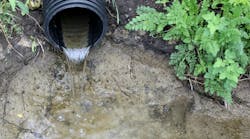Quantifying Increases in Stream Power and Energy
Watershed scientists use various methods to quantify urban impacts on stream channels. These methods, when focused specifically on the physical changes that occur in channels, include the following measurements: cross-section geometry change over time, bedload movement and sediment deposition at the reach scale, and shear stress and tractive force. One of the most remarkable changes in the urban stream environment, quantifiable with various equations used by hydrologists and engineers, is stream power. Stream power calculations are critical in understanding many of the scientific measurements listed above, as the available water power in the stream channel is the principal driver of physical change (Booth 1990).
Although traditional calculations of stream power are scientifically sound and adequate for discussion within the scientific community, they fall short of capturing, in layman’s terms, the raw and dramatic changes that occur in urban streams because of human impacts. In this article we propose an alternative, scientifically defensible method of interpreting stream power increases, albeit outside the realm of traditional scientific analysis of stream power, to help other watershed professionals convey the message of stream power increases to their nontechnical audiences.
Flow duration curves (FDCs) are a graphical depiction of streamflow values arranged from highest to lowest (y axis) and percent exceedence (x axis) at each interval. The source of the data can be actual gauged data or simulated data from a model output. FDCs are used throughout the watershed science community to predict return intervals for different streamflow events, often those large-magnitude events associated with flooding. FDCs provide one of the important pieces of data needed to calculate stream power: streamflow values. FDC data are also convenient for stream power calculations, because the time component allows for a quantification of stream power for specific flow durations (e.g., one-day return flow). The comparison of FDC data for a watershed under both forested and urbanized conditions provides the data needed to quantify stream power increases due to the effects of urbanization. When the effects of urbanization on stream power are considered for the infrequent streamflow events characterized by the upper end of a flow duration curve, being those high-flow events most effective in channel formation, increases are significantly large(Wissmar, Timm, and Logsdon 2004). Furthermore, when quantified increases in stream power and energy for these infrequent events are displayed in units commonly understood outside the scientific community (e.g., kilowatt-hours of energy, horsepower of machinery), results are impressive and have the potential to change the public’s perception about the magnitude of stormwater impacts in their own backyards.
Methods
Flow Duration Curves
FDCs were developed by Tetra Tech Inc. for the Vermont Agency of Natural Resources as a means of identifying hydrologic targets for total maximum daily load implementation in stormwater-impacted watersheds in Vermont. FDC data have been developed and calibrated for current conditions using gauged streamflow data and simulated for forested (pre-development) conditions using the P8 model (Saravanapavan and Parker 2004). Potash Brook, which has been the focal point in the discussion on stormwater in Vermont, was chosen as the study watershed because of the overall familiarity with the basin by the scientific and regulatory communities and the public alike. Potash Brook, which drains directly to Lake Champlain, has a watershed area of 7.5 square miles and is located predominately in the city of South Burlington (Figure 1). There is a mix of residential, commercial, and agricultural land uses within the watershed, with approximately 22% total impervious cover. Potash Brook is a low-gradient riffle-pool stream (average channel slope approximately 1.0%) with a width of 35 feet at its outlet.
The P8 model was configured to produce unitized streamflow (cubic feet per second per square mile) values at the outlet to Lake Champlain with an individual time step of 0.07 day, or approximately 1.8 hours (Figure 2).Model results used in FDC development include current watershed conditions and forested conditions with no impervious cover. Using the FDC data for analysis of annual return frequency of streamflow discharges and durations, we find that the 0.27% exceedence flow values represent the one-day flow for any given year (100% divided by 365 days), and the 0.55% exceedence flow values represent the one- and two-day flows combined for any given year. Bankfull flow events have return intervals of one-and-a-half to two days per year and are known to have the greatest impact on the formation of the stream channel (Leopold, Wolman, and Miller 1964). Thus, flow durations using the one- and two-day values were considered most important in quantifying increases in stream power and its ability to do work and actively form the channel.
Stream Power
Two equations are commonly used in the fields of hydrology and engineering for calculating stream power, yet their applications and resulting units are slightly different. Hydrologists typically calculate stream power using Equation 1 (Bagnold 1966; Ward and Trimble 2004).
In this equation the units, kilograms per meter per second, are describing the force exerted by a mass of water moving over and across a single cross-section per unit time. This equation is typically applied to studies of bedload movement to determine whether a stream reach is aggrading (sediment accumulation) or degrading (incision). On the other hand, general physics equations used for calculating mechanical power (horsepower, kilowatts) traditionally describe force per unit area. Although Equation 1 can be manipulated to calculate force per unit area by considering the longitudinal stream length with respect to slope, we have found another stream power equation to be more user-friendly and intuitive for our purposes. Equation 2 is the hydroelectric power calculation most commonly used by the engineering community to calculate potential power at a dam site (McKinney 1983).
Equation 2 describes the force exerted by a known volume of water descending a known vertical distance per unit time. Because this equation incorporates both the vertical and the force-per-unit-area components we were trying to capture, we have used it to quantify stream power using the FDC data for the flow periods of interest. We assumed a stream-reach length of 0.5 mile, and we calculated head using the average channel slope (2%) near the outlet of Potash Brook and the reach length. The efficiency coefficient is typically applied for thermal and mechanical losses of energy during the conversion of water energy to mechanical shaft energy in the turbine. Our calculations assumed 100% efficiency because in our case the stream’s energy is confined and absorbed within the channel during bankfull flow events.
Stream Power and Energy
Hydroelectric stream power was calculated using predicted streamflows from FDC data for the flow durations of interest (one-day and combined one- and two-day duration flow events). Using the time interval associated with each event (24 and 48 hours), total hydroelectric energy, or the cumulative energy available during each time period, was calculated using the following conversion: Kilowatts multiplied by duration (hours) = kilowatt-hours.
Using the cumulative hydroelectric energy calculated for current and forested conditions for the two flow durations, energy increases due to effects of urbanization were quantified using the following equation: Energy increase = current conditions cumulative energy — forested conditions cumulative energy.
Stream Energy Versus Machine Energy
Values for energy increases were converted to British thermal units (Btu) and used to calculate the duration of time the resulting energy would power a bulldozer, given the known energy usage of the machine. The bulldozer chosen for this calculation was a Caterpillar 824H, which is a typical medium-sized bulldozer that consumes approximately 10 gallons of diesel fuel per hour (Caterpillar 2005). Diesel fuel contains approximately 130,000 Btu per gallon, with a large percentage of this energy lost to heat in the internal combustion process (a great amount of mechanical work is lost). Given the known fuel usage of this machine, the quantity of bulldozer operation hours associated with each stream energy increase was calculated using the following equation: Number of bulldozer hours = energy increase (Btu)/1,300,000 (Btu per hour).
Results
Table 1 displays the results of cumulative stream energy increases calculated for Potash Brook for the two flow-duration periods considered in this analysis. For the one-day return flow, a total increase of 5,233 kilowatt-hours or 17,842,953 Btu were calculated from forested to current watershed conditions. For the one- and two-day return flow, a total increase of 6,235 kilowatt-hours or 21,261,550 Btu were calculated between the two watershed conditions.
Cumulative stream energy increases for two locations on Potash Brook have been translated into bulldozer operation hours and are displayed in Table 2. At the outlet of Potash Brook, energy increases are equivalent to 14 hours of bulldozer operation for the one-day return flow, and 16 hours of bulldozer operation for the one- and two-day return flow. Values prorated for Tributary 7, a smaller and highly impacted tributary of concern in the upper watershed, indicate that the energy increases for both flow durations are equivalent to three hours of bulldozer operation.
Discussion
Our results indicate that, given the energy increase from the one-day streamflow alone, a bulldozer could be operated in a 0.5-mile reach of Potash Brook near its outlet for 14 hours. Is this an accurate account of excess energy produced in a stream channel due to urbanization? Is the damage that could be caused by letting a bulldozer loose on a 0.5-mile reach of a small stream comparable to the physical changes occurring in the stream channel? Given the amount of active streambank erosion observed in the lower reaches of Potash Brook (Figure 3) and the channel adjustments occurring to accommodate this excess flow, it is plausible to relate the magnitude of bulldozer energy to that energy being expended in the channel during infrequent flow events. Note that for a smaller tributary of interest in the watershed, the prorated number of bulldozer hours was much reduced yet significant given the size of the drainage area and stream channel. Observations of bank failure in this tributary also suggest that our energy calculations are within the realm of possibility for this smaller channel.
We acknowledge that there are perhaps some “unscientific” assumptions that have been made in our calculations aimed at comparing stream and mechanical power and energy. It is difficult and perhaps impossible to make a true comparison between the mechanical work expended using a fuel-powered machine and the physical work expended by water in a stream channel. Geomorphologists understand that stream channels will adapt to changes in hydrologic regimes and become more or less efficient at transferring energy. Natural channel changes such as these make it difficult to understand expenditure of water energy in a watershed over time. With machines, great amounts of energy are lost to heat during the internal combustion process, further complicating this comparison.
Despite these difficulties, stream channel changes in response to urbanization are clearly dramatic and detrimental, and yet many scientific techniques used in assessing these changes fail to convey the magnitude of the impacts in familiar terms. In this analysis we have gone to the extreme of choosing the example of a bulldozer operating in the stream channel to impress upon the reader how powerful these changes can be. Bank erosion in urbanizing watersheds often produces an effect that is not unlike a bulldozer scouring down through a channel. The intent of our analysis is not to make a true scientific comparison between these two forces, but to stimulate a discussion in the watershed science community of how to bring attention to the problems we work on solving. Perhaps by using more familiar examples such as these, watershed scientists and land-use planners can get these important messages across to their nontechnical audiences more effectively.

